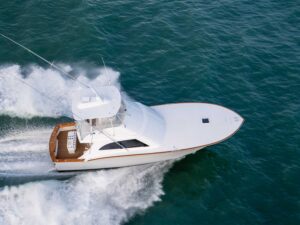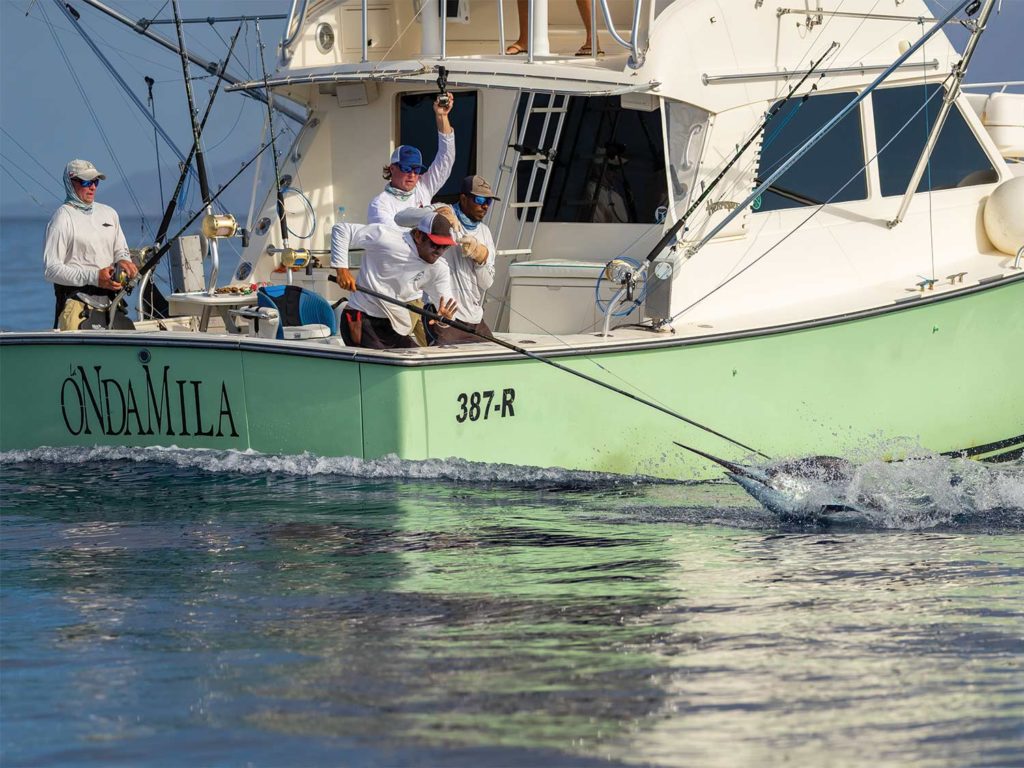
Without a doubt, a good mate—or team of mates—can be the difference between a good operation and a great one. It takes a lot to excel as a top deckhand in the sport-fishing industry today. Being well-versed in the many disciplines of fishing takes a great deal of patience, a strong desire to learn, and a will to succeed.
Looking back through time, a mate’s path to success was typically to hitch on with a captain and then learn everything they could. A prospect would sign on for a season or longer with a certain captain or boat, and if they were lucky enough that the boat moved around, they got to fish in different places and were able to pick up other techniques and nuances from crews on the dock. That was also the time to learn what not to do.
Watch: We show you how to rig one of the best baits for blue marlin: the swimming mackerel.
This gave the crewman a good chance to learn how to keep the boat running by assisting the captain in fixing things; learning how to properly maintain systems and the boat itself was a big part of the job. If they were on a charter boat, they learned it all, because missing any days due to breakdowns also meant a loss of income. To the charter captain, that is the focus: making the day’s pay for the boat, himself and the crew. And when the ship hits the fan offshore, a mate has to be able to handle the situation, not look into the hatch waiting for someone else to do something. There is no better teacher than experience.
The charter mindset speaks to a greater sense of being in the business for the long haul, while the tournament-fishing mentality of today seems more like an all-out investment in hopes of a quick return—basically a lottery ticket. Both are fine because they provide jobs and opportunities; however, it is increasingly harder to find mates to do boatwork. They are so busy freelancing on the tournament circuit and doing well enough in the pay department that they don’t need the boatwork. Ultimately, this leads to larger yard bills because the work still has to be done to maintain the asset.
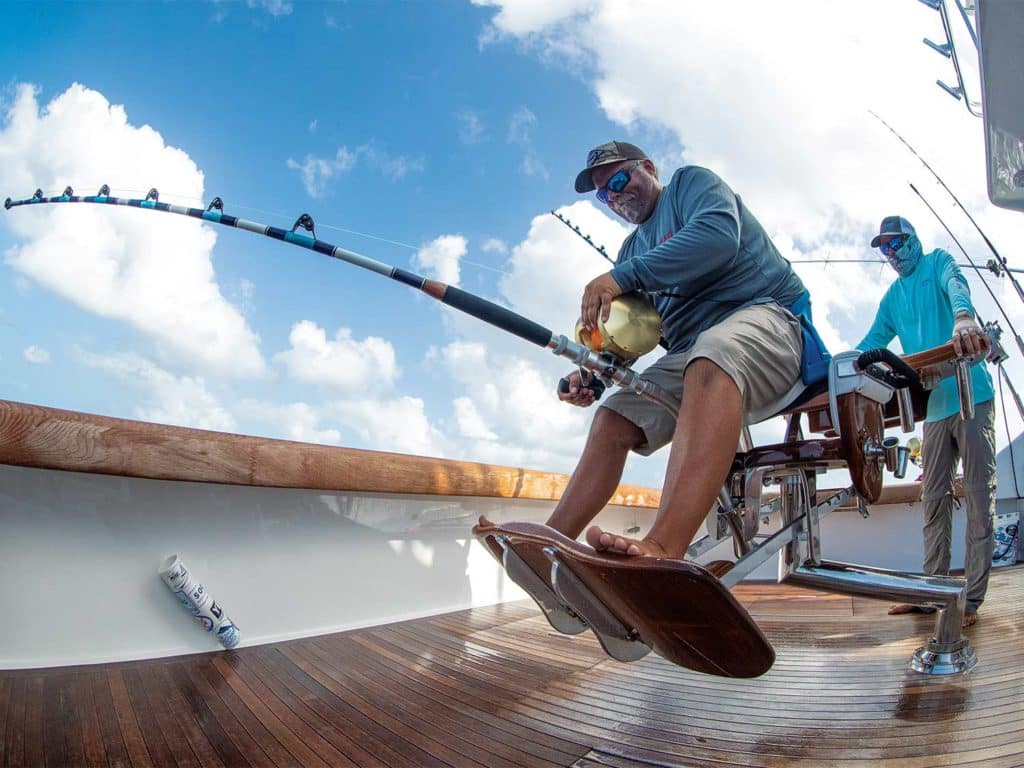
The Arms Race
This is all brought on by what I call the arms race, where our sport has become a numbers game. It is fed by social media and the competitive nature of sport fishing itself. Prior to the introduction of the dredge, it was typical for boats to have one or two crewmen for tournaments or heavy-tackle fishing. With the advent of the dredge, the introduction of prospecting, and the push for more bait in the water comes the requirement for more arms in the cockpit—more labor. More labor means more money, and if you’re going to compete, you’d better bring both.
The NASCAR guys say that speed costs money. In our sport, bites and catches cost money. It takes a lot of fuel, logistics, labor-intensive rigging, bait, terminal tackle, multiple sets of expensive teaser reels, a fast and well-built platform, and a host of other things—and it all equals dollars. One benefit of all the crewmembers it takes to compete is that the sharing of information is at an all-time high. With everyone freelancing around, there are no secrets! Being on the dock and watching who is working and how they work, it doesn’t take long to see the who the real pros are.
The Boat, the People, the Fish
Our approach has always been the boat, the people and the fish—in that order. It’s simple: I have been very lucky to work with the best equipment money can buy, so we have always treated the boat as both an asset and a tool. Maintaining it and keeping it in Bristol condition makes things easy when we have guests; the boat is always clean, and I’ve lost only one day of fishing in 30 years of running Brier Patch, and that was due to an engine-part failure. We quickly recovered and fished the next day, but it still stung missing that one single day.
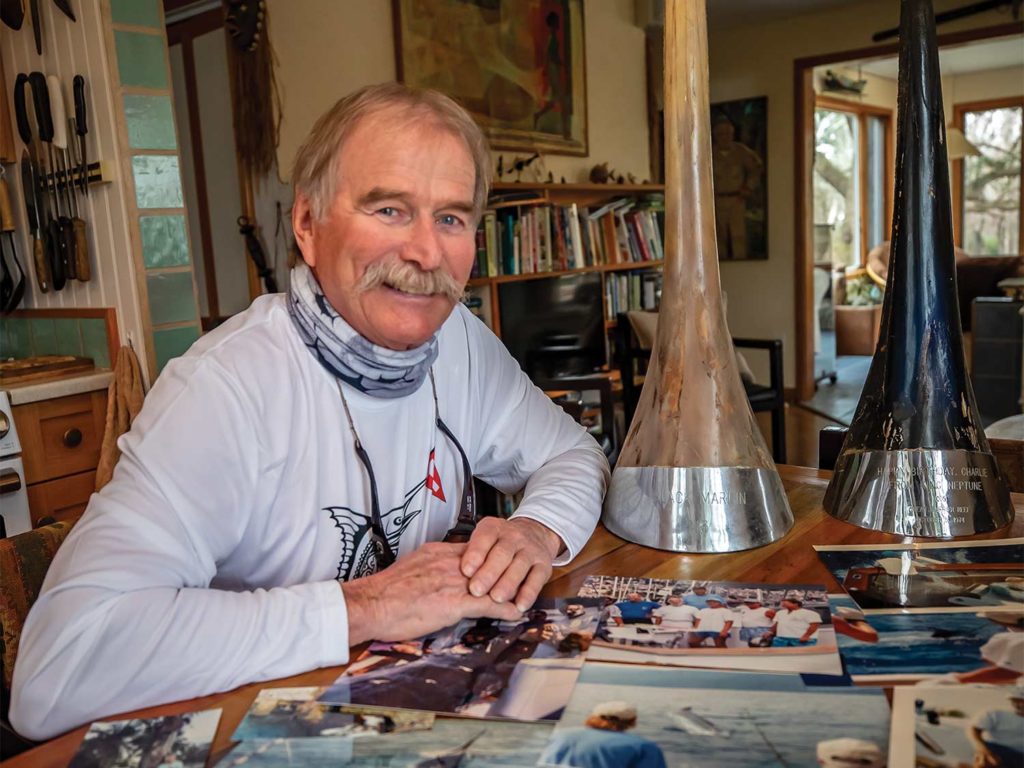
As Capt. Peter B. Wright used to say, “A clean boat is a happy boat.” Our guests can enjoy their time on board because the boat is always clean, neat and organized. The heads and linens are spotless, all systems are operable, we have the best tackle, and we are well-provisioned. This is also where the crew’s seamanship comes into play. Being able to evaluate the wind and current to properly tie up a boat when pulling into a slip—while also knowing what the captain will do in those situations and using that to their advantage—is huge. When the crew knows what to do and it’s seamless, it shows. The chain is only as strong as the weakest link, so when a crewmember isn’t in tune and on the ball, that also shows.
No one wants to pull into the slip with folks watching and be perceived as unprepared or unskilled. Knowing how to do these basic things properly helps protect the boat, which is our No. 1 priority. I have watched so-called experienced crews jump off at the dock and not know how to tie a half hitch to make the boat fast. It amazes me, but it is as common as a writer misspelling words.
The people part is easy as well. With a talented crewman to look after the guests, we make sure they always have what they need, whether it’s a cold drink, snacks, or a good joke during a slow day of fishing. We go out of our way to have good meals prepared, whether for lunch or dinner, and we make sure the libations are ample and that everyone is having fun. Whether we catch one or 20, the guests still have a nice time.
In a conversation with Brier Patch owner Mark O’Brien one evening, he said, “Time is the currency we’re all shortest of.” You have a limited amount of time on Earth, but for our purpose, I’ve always looked at his time aboard as limited, and we need to make it the best time possible. So, my crew and I would put forth the extra effort to maximize that time for him and the guests.
The fish part is so basic, it’s easy. Be sure the tackle is in top shape. Always have enough bait, ice and pre-made rigs to take advantage of a bite when it’s on. Being neat, organized and ready for any opportunity is key. Let the folks enjoy the catch, and gauge their skill level to determine how much help they need to make that catch. Anglers and guests have various levels of competence, and a good crewman knows how to observe and use that information to help them enjoy the day and not dread it.
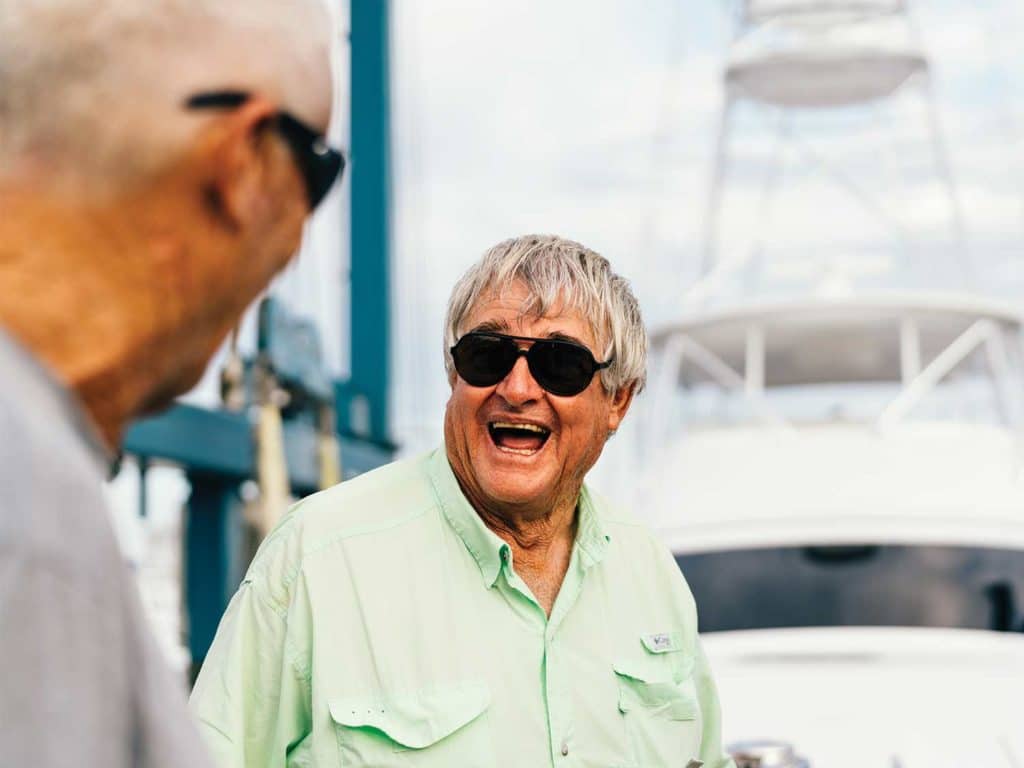
Shoulder to Shoulder
Another way to rapidly advance your skill level in the cockpit is to fish with an operation where there is another mate on deck. Signing on with an experienced crewman and gaining the tutelage that person offers will help to quickly raise the skill level and, when the bite is on, the speed of a deckhand.
Well-known mate Bo Jenyns and I had the opportunity to learn from Charles Perry, arguably the top mate/wireman in the business. Jenyns’ father had a mothership-and-gameboat operation fishing the Great Barrier Reef in Australia, and Perry ran the gameboat for several years. As a young hand, Jenyns was able to learn a good deal from him and Billy Fairbairn, a highly experienced Australian deckie that Jenyns also got to work alongside early in his career. I had the opportunity to fish with Perry on Tuna Alley off Bimini in the Bahamas, as well as in St. Thomas on the well-known 42-foot Merritt Cat’s Meow under Capt. John Sabonis for several seasons. The impact of those experiences was monumental for my career.
Oregon Inlet, North Carolina, has been the ultimate mate-training ground since the 1960s. The number of days fished, variety of species, number of charter clients, and caliber of captains and boats all make it the ideal place to learn and hone the craft of being a first-class deckhand. The captains at Oregon Inlet have all been mates there prior to taking the wheel, which is a huge part of why they are so good at what they do.
Capt. Chip Shafer forged a career in the charter business fishing out of Hatteras and Oregon Inlet in the summers and Stuart, Florida, in the winters. He is now on a private boat fishing the Pacific from Costa Rica to Mexico. Throughout his career, he has had a series of incredibly talented mates who have gone on to become some of the best captains on the rip today, guys such as John Bayliss, Arch Bracher, Mike Everly, Mike Brady and Jimmy Grant, to name just a few.
When looking for a mate, Shafer was in an area where he could keep his eye on the young guys coming up through ranks. Often, he found mates who already had experience but wanted to fish more, which his situation on a busy charter boat offered. “Over the years, I’ve had to do very little training,” he says. “I let them work it out by talking with other mates and letting them do their thing.” He continues, saying: “Mates have to have a drive and a love of fishing. If they look at it as a job, a 9-to-5 thing, they are in the wrong place, and it’s just not going to work. This job requires endless hours. It takes dedication.”
Capt. Jimmy Grant, a Shafer disciple, says: “Chip is the Cal Ripken Jr. of sport fishing. He’s the Iron Man. His endurance is amazing. I took several things with me from working in Oregon Inlet with Capt. Brynner Parks and Chip: You have to show up to the boat with a positive attitude and be willing to work hard, always giving 100 percent. There is no room for bad attitudes. You have to listen. Mates are to be seen and not heard. You not only must be punctual, but you also should always beat the captain to the boat and be readily available to help with all aspects of the operation, whether it’s in the engine room, running errands or whatever. The only way to really learn is to be hands-on, not through YouTube videos and social media posts.”
Perry has had a stellar career that started in Oregon Inlet; he has fished the world over—both heavy and light tackle—with the finest captains and anglers in the business. He sums it all up succinctly: “It’s long hours, early in the morning until late in the afternoon. You have to work hard, and be dedicated and dependable. You have to show up and be upbeat. If you love the sport and love what you’re doing, it’s fun, and it should be for you and those you are fishing with. You need to be good with people. Almost anyone can do a good job when fishing is good, but if the fishing is slow and the folks are still happy, that’s when you know you’ve done it right.”
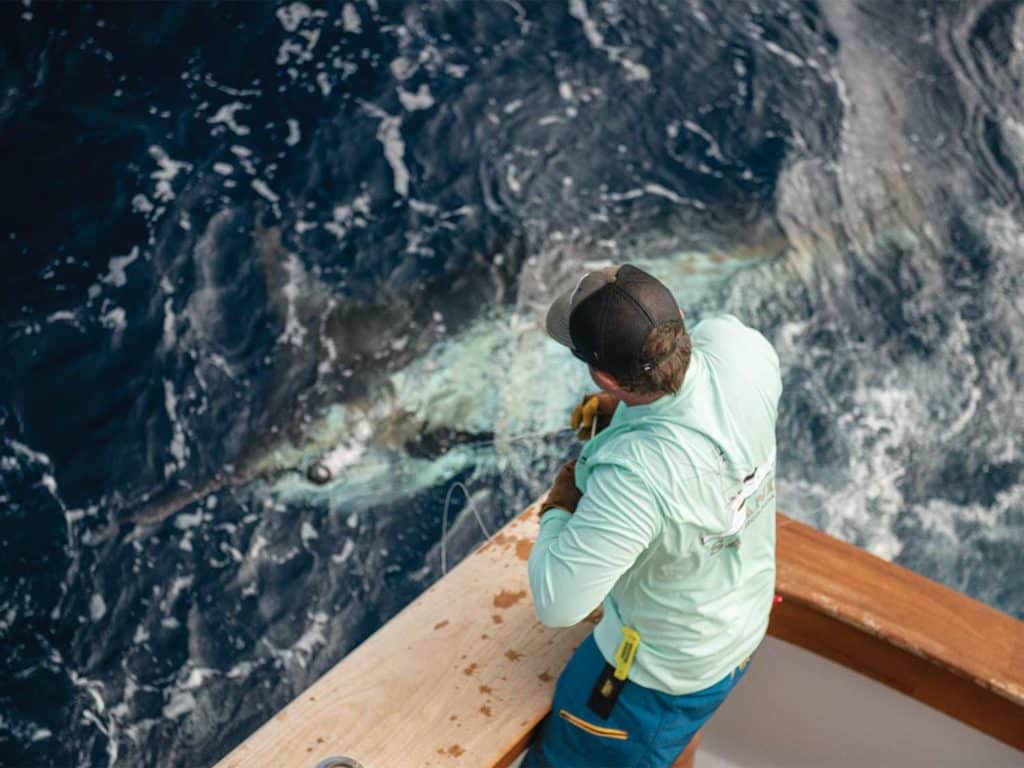
Regarding getting to know people, Perry shares a great story from his early career on a charter boat. “When I worked for Capt. Tony Tillett, he told me, ‘Once those folks pull into the parking lot, you have until we get to the sea buoy to tell me what kind of tip you’ll get.’ Once we got to the sea buoy, I’d go up on the bridge, and he’d say, ‘Here is $20—I’ll give you this, and you give me your tip if you think you won’t get more than this.’ I don’t ever remember taking his twenty. The point was, it made me engage with the party, learn how to read them, and make the experience better for them. It made me a better people person, and that’s one of the biggest parts of the job.”
He goes on to say: “I’ve been lucky in my career. I’ve been there at the right places at the right times for good fishing. I’m not wealthy, but I’ve made a good living. I’m wealthy in life. There are not many jobs in the world where you can make a living out of something you love. You never stop learning. Technology is constantly changing; techniques are always improving. This business encompasses two of my favorite things—travel and fishing—so for me, it has been incredible.”
Pushing to Become Better
When it comes to fishing and I have new mates, we work on the basics of getting the baits out, whether we are trolling or kite-fishing. Knowing what to do with the bite, and how to create multiple bites in the turn once you’re hooked up, without creating tangles, is paramount to being above average on any given day.
Once those basics are all solid, we work on the speed and efficiency to be able to take advantage of a hot bite without creating chaos. Obviously, the rigging and tackle setups that are needed to be efficient are primary tasks. Spooling new line on the reels, tying good knots, knowing terminal tackle, hook selection, keeping outrigger lines and clips in top shape, along with a host of other things, are part and parcel to efficiency and speed.
Read Next: Read our review of the new Duffie 64.
Today’s mates need to be up to speed on trolling either with lures or rigged baits. Kite-fishing is another skill with an assortment of little details that needs to be in the arsenal. Making bait of all kinds, being able to throw a cast net, bait rigging, live-baiting with large baits, and understanding the nuances of lure-fishing are just a few more things a well-rounded mate brings to the table. The dedicated mate knows where he needs more skill and seeks the opportunity to fish on a boat or with a crew to improve in his weak areas to become a better all-around fisherman.
Being a top-shelf mate is not an easy job, but it can be truly rewarding. Today’s pay rates are the highest the industry has ever seen. If you are willing to work, develop a wide knowledge base of the many types of fishing that might be in the schedule, maintain a good self-presentation, and take care of your guests, then you are well on your way to being on a premier boat in a premier destination.
This article originally appeared in the March 2022 issue of Marlin.
